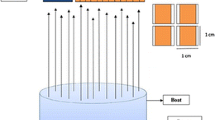Abstract
Indium aluminum tin oxide (IATO) films with high Hall mobility have been deposited on the SiO2 (0001) substrates by metal organic chemical vapor deposition. The structural, morphological, and optoelectronic properties of the IATO films with Sn contents varied from 0 to 18 % [Sn/(In+Al+Sn) atomic ratio] were studied in detail. Well-crystallized IATO film with the highest Hall mobility of 15.59 cm2 V−1 s−1 was obtained at 15 % of Sn content, and the corresponding carrier concentration and resistivity were about 2.38 × 1020 and 1.51 × 10−3 Ω cm, respectively. The average transmittance for all the obtained films in the visible range was over 81 %, and the optical band gap of the films changed in the range of 4.05–5.03 eV.







Similar content being viewed by others
References
Ohta H, Nomura K, Hiramatsu H et al (2003) Frontier of transparent oxide semiconductors. Solid State Electron 47:2261–2267
Kamiya T, Hiramatsu H, Nomura K et al (2006) Device applications of transparent oxide semiconductors: excitonic blue LED and transparent flexible TFT. J Electroceramics 17:267–275
Kim H, Gilmore CM, Pique A et al (1999) Electrical, optical, and structural properties of indium-tin-oxide thin films for organic light-emitting devices. J Appl Phys 86:6451–6461
Ohta H, Orita M, Hirano M et al (2000) Highly electrically conductive indium-tin-oxide thin films epitaxially grown on yttria-stabilized zirconia (100) by pulsed-laser deposition. Appl Phys Lett 76:2740–2742
Hamberg I, Granqvist CG (1986) Evaporated Sn-doped In2O3 films: basic optical properties and applications to energy-efficient windows. J Appl Phys 60:R123–R160
Minami T, Miyata T, Yamamoto T (1998) Work function of transparent conducting multicomponent oxide thin films prepared by magnetron sputtering. Surf Coat Tech 108:583–587
Nomura K, Ohta H, Takagi A et al (2004) Room-temperature fabrication of transparent flexible thin-film transistors using amorphous oxide semiconductors. Nature 432:488–492
Wu GM, Liu CY, Sahoo AK (2015) RF sputtering deposited a-IGZO films for LCD alignment layer application. Appl Surf Sci 354:48–54
Kamiya T, Hosono H (2010) Material characteristics and applications of transparent amorphous oxide semiconductors. NPG Asia Mater 2:15–22
Jeong JK, Yang HW, Jeong JH et al (2008) Origin of threshold voltage instability in indium–gallium–zinc oxide thin film transistors. Appl Phys Lett 93:123508
Chen TC, Chang TC, Hsieh TY et al (2010) Light-induced instability of an InGaZnO thin film transistor with and without SiOx passivation layer formed by plasma-enhanced-chemical-vapor-deposition. Appl Phys Lett 97:192103
Wager JF (2003) Transparent electronics. Science 300:1245–1246
Qin X, Dong H, Brennan B et al (2013) Impact of N2 and forming gas plasma exposure on the growth and interfacial characteristics of Al2O3 on AlGaN. Appl Phys Lett 103:221604
Zhang Z, Li L, Yang JC (2011) γ-Al2O3 thin film formation via oxidation of β-NiAl (110). Acta Mater 59:5905–5916
Du XJ, Li Z, Luan CN et al (2015) Characterization of tunable band gap aluminum indium oxide films prepared on SiO2 (0001) by MOCVD. J Mater Sci: Mater Electron 27:599–605
Orita M, Ohta H, Hirano M et al (2000) Deep-ultraviolet transparent conductive beta-Ga2O3 thin films. Appl Phys Lett 77:4166
Zhang DH, Ma HL (1996) Scattering mechanisms of charge carriers in transparent conducting oxide films. Appl Phys A 62:487–492
Koshizaki N, Umehara H, Oyama T (1998) XPS characterization and optical properties of Si/SiO2, Si/Al2O3 and Si/MgO co-sputtered films. Thin Solid Films 325:130–136
Du J, Huang L, Chen Z et al (2009) A controlled method to synthesize hybrid In2O3/Ag nanochains and nanoparticles: surface-enhanced Raman scattering. J Phys Chem C 113:9998–10004
Yan L, Pan JS, Ong CK (2006) XPS studies of room temperature magnetic Co-doped SnO2 deposited on Si. Mater Sci Eng 128:34–36
Liu J, Deng H, Zhu L et al (2014) Structure, optical and magnetic properties of Bi1-xEuxFeO3 films fabricated by pulsed laser deposition. Appl Surf Sci 316:78–81
Zhou B, Rogachev AV, Liu Z et al (2012) Effects of oxygen/argon ratio and annealing on structural and optical properties of ZnO thin films. Appl Surf Sci 258:5759–5764
Lu JG, Fujita S, Kawaharamura T et al (2007) Carrier concentration dependence of band gap shift in n-type ZnO:Al films. J Appl Phys 101:83705
Acknowledgements
This work is financially supported by the National Natural Science Foundation of China (Grant No. 51272138).
Author information
Authors and Affiliations
Corresponding author
Rights and permissions
About this article
Cite this article
Du, X., Wang, W., Wang, M. et al. Effect of Sn content on the structural and photoelectric properties of IATO films. J Mater Sci 52, 367–374 (2017). https://doi.org/10.1007/s10853-016-0337-2
Received:
Accepted:
Published:
Issue Date:
DOI: https://doi.org/10.1007/s10853-016-0337-2



